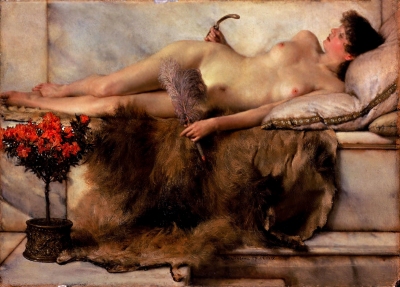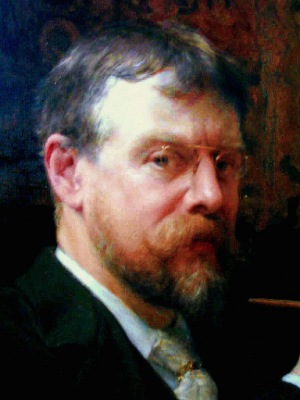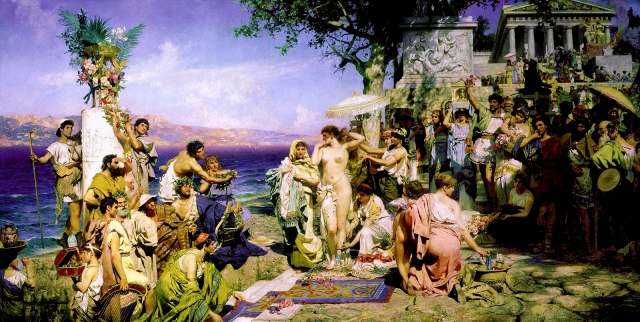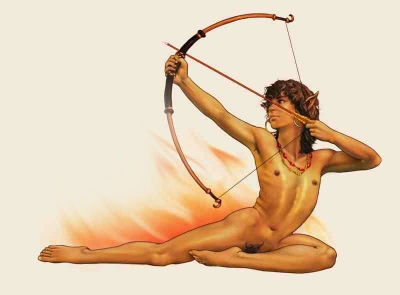Joseph Désiré Court 1797-1865

Ανδρομέδα – ‘ANDROMEDA’ – (1969)
Gustave Doré – (1832-1883)
Frederic Lord Leighton – (1830 – 1896)
Frederic Lord Leighton – (1830 – 1896)
Frederic Leighton, 1st Baron Leighton PRA (3 December 1830–25 January 1896), known as Sir Frederic Leighton, Bt, between 1886 and 1896, was an English painter and sculptor.
His works depicted historical, biblical and classical subject matter.
Leighton was born in Scarborough to a family in the import and export business. He was educated at University College School, London. He then received his artistic training on the European continent, first from Eduard Von Steinle and then from Giovanni Costa.
When in Florence, aged 24, where he studied at the Accademia di Belle Arti, he painted the procession of the Cimabue Madonna through the Borgo Allegri.
He lived in Paris from 1855 to 1859, where he met Ingres, Delacroix, Corot and Millet.
In 1860, he moved to London, where he associated with the Pre-Raphaelites.
He designed Elizabeth Barrett Browning’s tomb for Robert Browning in the English Cemetery, Florence in 1861.
In 1864 he became an associate of the Royal Academy and in 1878 he became its President (1878–96). His 1877 sculpture, Athlete Wrestling with a Python, was considered at its time to inaugurate a renaissance in contemporary British sculpture, referred to as the New Sculpture.
His paintings represented Britain at the great 1900 Paris Exhibition.Leighton was knighted at Windsor in 1878, and was created a Baronet, of Holland Park Road in the Parish of St Mary Abbots, Kensington, in the County of Middlesex, eight years later.
He was the first painter to be given a peerage, in the New Year Honours List of 1896. The patent creating him Baron Leighton, of Stretton in the County of Shropshire, was issued on 24 January 1896.
Leighton died the next day of angina pectoris.
Frederic Lord Leighton – (1830 – 1896)
Frederic Lord Leighton – (1830 – 1896)
Frederic Lord Leighton – (1830 – 1896)
Frederic Lord Leighton – (1830 – 1896)
Sir Lawrence Alma-Tadama – (1836-1912)
Sir Lawrence Alma-Tadema OM, RA (8 January 1836 – 25 June 1912) was one of the most renowned painters of late nineteenth-century Britain.
Born in Dronrijp, the Netherlands, and trained at the Royal Academy of Antwerp, Belgium, he settled in England in 1870 and spent the rest of his life there.
A classical-subject painter, he became famous for his depictions of the luxury and decadence of the Roman Empire, with languorous figures set in fabulous marbled interiors or against a backdrop of dazzling blue Mediterranean sea and sky.
Admired during his lifetime for his draftsmanship and depictions of Classical antiquity, he fell into disrepute after his death, and only since the 1960s has his work been reevaluated for its importance within nineteenth-century English art.
Sir Lawrence Alma-Tadama – (1836-1912)
John William Waterhouse – (1849 – 1917)
Henryk Siemiradzki (1843 – 1902)
Henryk Siemiradzki (1843 – 1902)
Henryk Siemiradzki (15 November 1843 – 23 August 1902) was a Polish Academic painter.
He was particularly known for his depictions of scenes from the ancient Graeco-Roman world and the New Testament.
Siemiradzki was born to a Polish szlachta family of a military physician in the village of Novobelgorod (now Pechenegi) near Kharkiv, Ukraine.
He studied at Kharkiv Gymnasium where he learned painting under a scion of Karl Briullov, D. I. Besperchy. He entered the Physics-Mathematics School of Kharkov University but continued his painting lessons from Bespechy.
After graduating from the University with the degree of Kandidat he abandoned his scientific career and moved to Saint Petersburg to study painting at the Imperial Academy of Arts in the years 1864-1870. Upon his graduation he was awarded a gold medal.
In 1870-1871 he studied under Karl von Piloty in Munich on a grant from the Academy.
In 1871 he moved to Rome, while spending summers at his estate in Strzalkowo, near Czestochowa in Poland.
In 1873 he received the title of an Academician of the Imperial Academy of Arts for his painting Christ and a Sinner, based on a verse by Aleksey Konstantinovich Tolstoy.
In 1876-1879 Siemiradzki worked on frescoes for the Cathedral of Christ the Saviour (Moscow).
In 1879 he offered one of his best-known works, the enormous Pochodnie Nerona (Nero’s torches), painted 1876, to the fledgeling Polish National Museum in Kraków.
In 1893 he worked on two large paintings for the State Historical Museum (Moscow).
His works are exhibited in the museums of Poland, Russia and Ukraine.
He died in Strzalkowo in 1902. Originally he was buried in Warsaw but later his remains were moved to the national Pantheone on Skalka in Kraków.
Henryk Siemiradzki (1843 – 1902)
Henryk Siemiradzki (1843 – 1902)
Henryk Siemiradzki (1843 – 1902)
Henryk Siemiradzki (1843 – 1902)
Henryk Siemiradzki (1843 – 1902)
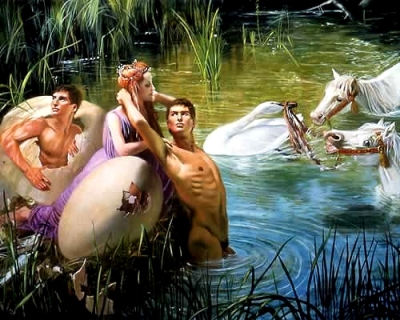

In Greek mythology, Icarus is the son of the master craftsman Daedalus.
The main story told about Icarus is his attempt to escape from Crete by means of wings that his father constructed from feathers and wax.
He ignored instructions not to fly too close to the sun, and the melting wax caused him to fall to his death.
The myth shares thematic similarities with that of Phaëton, and is often depicted in art.
Sagittarius is the ninth astrological sign in the Zodiac, originating from the constellation of Sagittarius.
Sagittarius is considered a “masculine”,positive (extrovert) sign. It is also a fire sign and one of the four mutable signs.
Sagittarius is ruled by the planet Jupiter, and individuals born when the sun was in this sign are considered Sagittarius individuals.
In Greek mythology, Sagittarius is identified as a centaur: half human, half horse.
In some legends, the Centaur Chiron was the son of Philyra and Saturn, who said to have changed himself into a horse to escape his jealous wife, Rhea.
Chiron was eventually immortalized in the constellation of Centaurus or Sagittarius.
March 5, 2011 | Categories: Art, Drawing, Female Nude, Male Nude, Mythology, Oil Painting | Tags: 19th century, A COIGN OF VANTAGE, A NAIAD, academic, Ancient Greece, Ancient History, Ancient Rome, André Durand, ANDROMEDA, Architecture, Art, ATENA, Athena, athlete, Austria, bathing, Beach, bild, bilder, Briton Rivière, building, CASTOR & POLLU, cga, cgi, CHARON FERRYING THE SHADES, classical, Classicism, computer generated art, CUPID COOLING, DAPHNEORIA, DIRCE, drawing, Egypt, ephebe, ephebos, etude, FAUN WITH A SWORD, FAUNO CON SPADA, female nude, figurative, fine art, flickr, Franz Stuck, Frederick Lord Leighton, free standing, full frontal, Gallery, giove e semele, Great Art, Great Art Blog, Great Art Wordpress, Grecian, Greece, Greek, Greek Mythology, Gustave Doré, Hellenic, Hellenisitc, Henryk Siemiradzki, Herbert Draper, History, History painting, homme nu, IDYLL, impresionismo, impresionista, impressionism, impressionist, Ivo Saliger, John William Waterhouse, junge, Klinger, knaben nakt, Knabenakt, LA JEUNESS DE BACCHUS, legend, Leighton, London, Ma, male nude, modelling, Museum, Myth, mythologie, Mythology, naked boy, naked girl, nakt, neoclassical, Neoclassicism, nude, nude boy, nude girl, nude male, nude study, nudo, nudos, oil painting, otolo, Painting, Pallas Athene, PERSEUS, Peter Crawford, Peter Crawford 1946, photoshop, PHRYNE, Pierre Subleyras, Pieter Paul Rubens, PROMETHEUS BOUND, PSYCHE ET L'AMOUR, Roman, Rome, scribd, Sculpture, sea, SEA MELODIES, Siemiradzki, sketch, study, sun, surf, swimming, teen, teenager, temple, THE BATH OF PSYCHE, The Hit, The Judgement of Paris, THE PATRICIAN SIESTA, THE TORCHES OF NERO, THE YOUTH OF BACCHUS, Vestal, Vittorio Carvelli, water color, William Adolphe Bouguereau, wordpress, young boy, youth | 1 Comment










